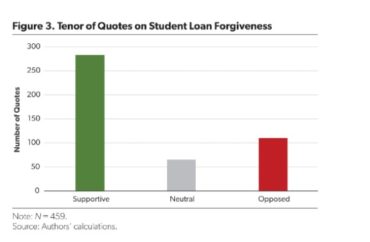
Most media put a positive slant on the $400 billion ‘forgiveness’ program, report found
U.S. newspapers reporting on President Joe Biden’s student loan forgiveness program were strongly biased in favor of the administration’s bailout, according to a report released Tuesday that reviewed more than eight dozen articles on the topic.
“An analysis of 100 news stories from five major newspapers regarding President Joe Biden’s proposal to unilaterally ‘forgive’ $400 billion in student loan debt finds a strong pro-administration bias in the coverage,” education policy researchers Frederick Hess and Caitlyn Aversman wrote in the report.
The authors of the AEI analysis examined samples of news coverage of the loan forgiveness program between May 1 and Nov. 8, 2022 by five major newspapers: the Los Angeles Times, the New York Times, the Wall Street Journal, USA Today, and the Washington Post.
It is worth considering how the program was covered in the media, as “serious concerns were raised about the proposal’s legality, cost, fairness, and potential inflationary impact,” according to the report.
Produced and funded by the American Enterprise Institute, a conservative think tank, the report is titled “The Media’s Slanted Coverage of Biden’s Student Loan Forgiveness Plan.”
Hess is senior fellow and the director of education policy studies at AEI. Aversman is a research assistant in the department.
The Biden administration announced last August that the government would absorb $10,000 (or up to $20,000 for Pell Grant recipients) for loan borrowers making less than $125,000 per year and households making less than $250,000,” The College Fix reported.
The debt relief program has been halted by legal challenges, but a pause on payments has been extended until dispute has been resolved, according to studentaid.gov. The program is no longer accepting applications.
Media overlooked ‘serious concerns’
The Washington Post editorial board published an op-ed in August 2022 titled “Biden’s student loan forgiveness is an expensive, regressive mistake.”
Using the search engine ProQuest, researchers searched the newspapers for relevant keywords and identified topical articles, according to the report. The analysis “included only news coverage,” excluding editorials, op-eds, and other opinion writing, the report stated.
Their search brought up 182 articles, from which they randomly selected 100.
The analysis focused on specific topics: who was quoted, how often were borrowers quoted rather than taxpayers or policy experts, what was the balance of critical and positive coverage, and how the stories discussed disputed issues.
Nearly 50 percent of the quotes in the 100 sampled stories were provided by public officials, more than half of which were provided by members of the Biden administration, the research found.
Borrowers and bailout advocates provided nearly 30 percent of the quotes, policy and legal experts offered just under 20 percent, and taxpayers or taxpayer advocates offered just over three percent.
“Overall, sources speaking on behalf of borrowers outnumbered those identified as experts by 1.6 to one and those speaking on behalf of taxpayers by eight to one,” researchers found.
The authors’ tally of quotes from all sources found that a clear majority, 62 percent, supported the loan bailout, 24 percent expressed criticism, and 14 percent were neutral.
The analysis found that very few sampled articles touched on the legality of the bailout.
“Readers could consume the lion’s share of coverage following Biden’s unprecedented proposal and never even encounter the law that the White House said authorized the president’s action,” the authors stated.
Less than half of the articles, 48 percent, mentioned the estimated cost to taxpayers, approximately $400 billion, the analysis found.
Just 34 percent considered its “regressive nature” in the context of fairness. Twenty-four percent of news articles covered the potential for inflation, and just half of stories told readers about any pre-existing debt-relief programs, such as income-driven repayment.
“The good news is that the headlines in the major newspapers were generally impartial,” the authors stated.
However, “when it came to the articles’ substance, news coverage in the nation’s leading newspapers showed a distinct tilt in favor of the Biden administration’s controversial loan forgiveness proposal.”
Overall, the press neglected to explain the issues thoroughly and present both sides of the issue, the authors concluded.
The Fix reached out to the study authors to ask what they believed motivated or explained the media bias and whether additional research has identified news sources that provided a more balanced approach. It has not yet received a response.
MORE: Biden proposes student loan payment reductions in advance of SCOTUS bailout ruling
IMAGE: American Enterprise Institute
Like The College Fix on Facebook / Follow us on Twitter





Please join the conversation about our stories on Facebook, Twitter, Instagram, Reddit, MeWe, Rumble, Gab, Minds and Gettr.